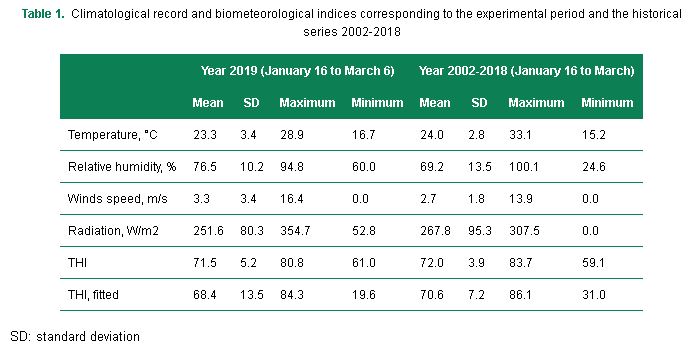Effect of supplementation with distillery grains and day confinement on the productive performance of Hereford steers, which graze forage sorghum (Sorghum, spp.) during the summer
Main Article Content
Abstract
In the West Coast of Uruguay, on six ha of forage sorghum, the effect of supplementation with more soluble dry distillery grains and day confinement with shade was evaluated on the productive performance of Hereford steers, which graze forage sorghum. A total of forty-eight steers (267 ± 29.5 kg) were randomly assigned to four treatments in a 2 x 2 factorial arrangement: free grazing without supplement, free grazing with supplement, day confinement without supplement, day confinement with supplement (n=2. 6 steers/repetition). It was grazed in weekly strips, with allocation of 8 kg of dry matter of grass/100 kg of live weight. Between 10:00 a.m. and 4:00 p.m., the animals with day confinement were moved from the grass to a near pen, provided with water and artificial shade. The supplementation with more soluble dry distillery grains improved productive performance, regardless of grazing management. Supplementation increased dry matter intake and increased live weight gain 2.9 times, with a weight gain response of 0.928 kg/d and supplement conversion efficiency of 3.1:1 (supplement intake, kg/response in LW gain, kg). The day confinement improved the thermal welfare of animals and did not affect the intake of dry matter or grazing activity. However, it was not enough to express improvements in mean daily gain.
Key words: steers, supplementation, more soluble dry distillery grains, day confinement.
Article Details
Those authors that have publications with this journal accept the following terms:
1. They will retain their copyright and guarantee the journal the right of first publication of their work, which will be simultaneously subject to the License Creative Commons Attribution-NonCommercial 4.0 International (CC BY-NC 4.0) that allows third parties to share the work whenever its author is indicated and its first publication this journal. Under this license the author will be free of:
- Share — copy and redistribute the material in any medium or format
- Adapt — remix, transform, and build upon the material
- The licensor cannot revoke these freedoms as long as you follow the license terms.
Under the following terms:
- Attribution — You must give appropriate credit, provide a link to the license, and indicate if changes were made. You may do so in any reasonable manner, but not in any way that suggests the licensor endorses you or your use.
- NonCommercial — You may not use the material for commercial purposes.
- No additional restrictions — You may not apply legal terms or technological measures that legally restrict others from doing anything the license permits.
2. The authors may adopt other non-exclusive license agreements to distribute the published version of the work (e.g., deposit it in an institutional telematics file or publish it in a monographic volume) whenever the initial publication is indicated in this journal.
3. The authors are allowed and recommended disseminating their work through the Internet (e.g. in institutional telematics archives or on their website) before and during the submission process, which can produce interesting exchanges and increase the citations of the published work. (See the Effect of open access).
